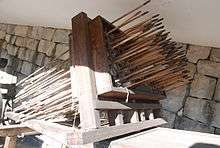Singijeon
Singijeon or shinkichon (magical machine arrows) was a type of Korean (Joseon) fire arrow rocket, used during the era of the Joseon Dynasty (1392–1897). Multiple singijeon could be launched by hwacha (multiple rocket launcher).[1]
| Singijeon | |
 | |
| Korean name | |
|---|---|
| Hangul | 신기전 |
| Hanja | |
| Revised Romanization | Singijeon |
| McCune–Reischauer | Sin'gijŏn |
History
During the late 14th century, in order to gain ascendancy at sea against Japanese pirates (wokou, also known as waegu in Korean), fire arrows called hwajeon or hwajon were used, which would become the predecessor of the singijeon.[2][3] The Koreans had tried to acquire rockets and gunpowder and their production methods from China. The Chinese, however, regarded the technology of gunpowder as a state secret and restricted access to it and trade in its nitrous raw materials (which could only be found in China). The Koreans therefore sought to acquire the manufacturing secrets of gunpowder for themselves and, in 1374 (~1376), Choe Mu-seon was able to bribe a Han Chinese merchant to obtain the secret formula for manufacturing gunpowder, as well as technical knowledge about Chinese firearm and cannon technology. He also successfully extracted potassium nitrate from the soil[4] and rocks from Japanese trade routes, and developed Korea's first gunpowder.
The singijeon saw most of its early use in the northern borders of Joseon, in the campaign to expand its northern borders by driving out the "Orangkae" ("Barbarians", especially referring the Jurchen people). Later, its uses expanded to coastal defence against Japanese pirates and was much used throughout the conflicts during the Joseon Dynasty. During the Imjin War, General Gwon Yul attributed his successful defense of the Haengju mountain fortress against numerically superior Japanese forces to the singijeon.[5]
Details of the singijeon were not known until very recently. Korean historians had found the schematics added as an appendix in the book Gukjo Orye Seorye (국조오례서례, 國朝五禮序例) but did not realize what they were until the academic Chae Yeon-suk identified them as the lost schematics of the singijeon. The schematics detail the lengths of wooden materials, using units down to 0.3mm. The schematics are one of the best representations of the acute scientific understanding of the Joseon Dynasty.
Overview
Singijeon were divided among three major types: large, medium, and small. The 52 cm long rocket was launched individually on a handheld gun, and the launch was initiated by a fuse in the tube. Even after launch, the fuse would remain in the tube, consuming the black powder until it hit the "warhead" and caused detonation.[6] The fuse length was determined by the amount of gunpowder in the paper tube, and was adjusted depending on the distance that the missile had to cover so that it would explode on the target. Its range was around 1 to 2 kilometers.[7] The medium singijeon was of the same construction and function as the large singijeon, but, due to its smaller size of 13 cm,[6] its range was limited to 150 meters.[8] However, its explosive warhead was still powerful enough to make a 30 cm-deep crater in a patch of sand.[5] The small singijeon was simply an arrow with a gunpowder pouch attached to it, and had no explosive capabilities. It was launched in multiples of 100 by a hwacha, and had a range of 100 meters. All gunpowder weapons including the singijeon used black powder.
See also
- The Divine Weapon
- Korean bow
- Firework
- Huolongjing
- Korean cannon
- Chongtong
References
- Kim, Myung Oak; Jaffe, Sam (2010). The new Korea: an inside look at South Korea's economic rise. AMACOM Div American Mgmt Assn. p. 149. ISBN 978-0-8144-1489-7. Retrieved 2012-05-30.
- Fifty Wonders of Korea, Volume 2, Korean Spirit and Culture Series, Authors Korean Spirit & Culture Promotion Project, Diamond Sutra Recitation Group, Publisher Korean Spirit & Culture Promotion Project, 2007, ISBN 0-9797263-4-4, ISBN 978-0-9797263-4-7 P.51-60
- Science and Technology in Korean History: Excursions, Innovations, and Issues, Jain Publishing Company, 2005, ISBN 0-89581-838-8, ISBN 978-0-89581-838-6 P.82
- Seoul National University
- 절대강국을 꿈꾼 세종의 비밀병기 <신기전>
- Digital Hangookhak Archived 2007-09-26 at the Wayback Machine
- Nolruwa.pcBee.co.kr Archived 2006-09-13 at the Wayback Machine
- Gwahak Jilmoon QnA Archived 2007-03-11 at the Wayback Machine